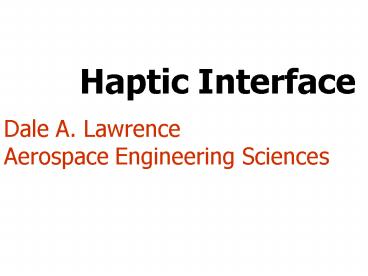Haptic Interface - PowerPoint PPT Presentation
1 / 24
Title:
Haptic Interface
Description:
Surface properties: convexity, curvature. Approach. Develop technology to allow objects ... Objects have distinctive sounds when touched. Experiments/Questions ... – PowerPoint PPT presentation
Number of Views:250
Avg rating:3.0/5.0
Title: Haptic Interface
1
Haptic Interface
Dale A. Lawrence Aerospace Engineering Sciences
2
Assistive Technology
Lucy Y. Pao Electrical Computer Engineering
Boulder Campus
3
for Spatial Learning
Howard Kramer CU Disability Services Center
4
(No Transcript)
5
(No Transcript)
6
Haptic Interfaces
- Enable people to communicate with a computer by
using their hands to manipulate as well as feel
virtual objects, which can be - Representations of remote objects
(tele-manipulation) - Computer-generated objects (virtual reality)
- Provide an additional channel for human-computer
interaction - Complement vision in 3-dimensional environments
- Promote active exploration through direct
manipulation and tactile sensing of virtual
objects
7
Direct Manipulation
Haptic Interfaces in Tele-manipulation and
Virtual Reality
Remote Environment
Tele-manipulation
Haptic Interface
Computer- Generated Virtual Environment
Operator
Virtual Reality
8
University of Colorado Visual/Haptic Interface
Testbed
- Used here for scientific visualization
- of magnetic fields
- Visual display shows magnetic flux vectors as
streamlines
- Pointer glyph
- matches hand motion
- Data at pointer location is felt as force /
torque on the hand
9
(No Transcript)
10
(No Transcript)
11
Spatial Learning
- Conventional visual/haptic computer interfaces
utilize previously developed haptic/spatial
perceptual and cognitive abilities
Can haptic interfaces be used to assist in the
development of spatial perceptual and cognitive
abilities?
12
Current NSF ProjectHaptic Interfaces for
Spatial Learning2001-2004
- Goal is to develop a multi-modal
visual/haptic/audio interface for learning,
using, and communicating spatial concepts. - Target populations include those with spatial
learning disabilities and those with vision
impairments.
13
- Project Focus
- Spatial concepts that are difficult
- to learn/convey with traditional
- 2-dimensional graphical displays
- Object shape
- Object position and orientation
- Relative location/orientation of objects
- Object contact/interference
- Intersection contours and volumes
- Projections onto viewing/cut planes
- Surface properties convexity, curvature
14
(No Transcript)
15
(No Transcript)
16
Approach Develop technology to allow objects to
be directly sketched in 3D
Initial stylus position establishes cone apex and
central axis
Initial stylus position establishes cone apex and
central axis
- Use simple shapes as a basis set for more
complex objects - Make their specification using stylus motion
simple and intuitive
Next stylus position establishes cone height and
angle q
Next stylus position establishes cone height and
angle q
Cone object
Cone object example
17
Approach (cont.)
Stylus can explore the object by touching or
pushing through the surface shell
- Manipulate objects directly to position and
attach parts together - Explore objects using haptic effects such as a
hard shell on objects, and internal viscous
resistance to motion
Cone object
Stylus glyph can grab the object, so object moves
with hand motions
18
Project Plan
Year 1
Year 2
Year 3
- Develop a commercializable interface
incorporating the most useful features from
previous experiments
- Augment existing interface hardware with speech
and audio capabilities - Modify existing interface software to enable
sketching and exploration of simple objects in
3D
- Conduct experiments on the efficacy of various
methods of learning, communicating, and exploring
3D spatial constructs
19
(No Transcript)
20
(No Transcript)
21
Technology Development
- Augment the existing visual/haptic interface
- to enable direct 3D drawing/exploration using
simple shapes, e.g.
Two cones, merged to form a vase
Table top constructed as a rectangular box
Objects have distinctive sounds when touched
Haptic grooves and tick marks to assist in
accurate navigation and positioning
22
Experiments/Questions
- What types of haptic interface modes enable
improved learning/communication of 3D concepts
over conventional 2D drawings alone? - Can blind users draw and communicate 3D concepts
more accurately using a haptic/speech/audio
interface? - Do techniques that assist the blind provide new
insights for sighted users? - Does the use of multi-modal interaction
(vision/haptic/audio) enhance development of
3D spatial skills for those with learning
disabilities?
23
Wanted
- Collaboration outside engineering
- Cognitive sciences
- Experimental psychology
- Developmental psychology
- Learning theory
- Learning disorders
- Psychophysics
24
(No Transcript)































